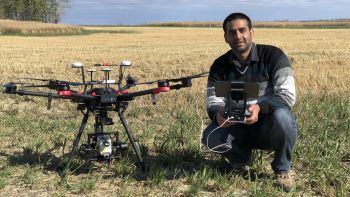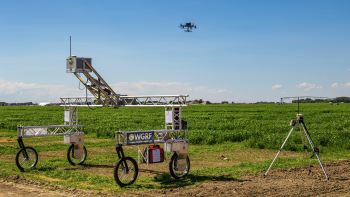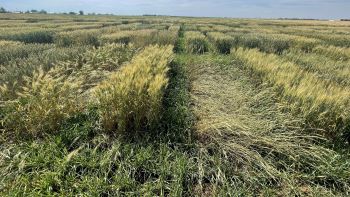Media Relations
Agriculture and Agri-Food Canada
1-866-345-7972
aafc.mediarelations-relationsmedias.aac@agr.gc.ca
When you think about agricultural science, you might think back to your high school biology textbook with Mendel and his pea crossing experiments. However, technology and the volume of data have come a long way since then, and AAFC scientists are at the forefront of putting these new resources into practice.
Dr. Keshav Singh at AAFC's Lethbridge Research and Development Centre is a specialist in these innovative research technologies. While there are many applications for these tools, such as remote sensing and artificial intelligence, an area of significance for Dr. Singh and AAFC researchers is in phenomics: the study of living things' observable characteristics and the interplay between genes and environmental factors.
What are these digital technologies?
Digital technologies in agriculture include a range of autonomous equipment and sensors that integrate image-based information, data utilization, and technology development. These tools empower users make data-driven decisions, optimizing efficiency and enhancing productivity. In the case of on-farm application, this is sometimes called "smart farming."
In the world of modern agricultural science, it could be said that "smart research" tools are being applied as well. While conventional research techniques are often subjective, time consuming and labour intensive-novel research techniques can analyze vast quantities of data utilizing computers, which in this case are AI programmed to search for certain patterns - or valuable traits and qualities. Likewise, data can be collected more quickly and accurately by a camera moving through field plots than by a human with a notepad. The more quickly data can be analyzed, the more quickly researchers can draw conclusions that can be applied to farmer-focused agronomic practices and the development of new crop varieties.
Dr. Singh's team is pursuing a unique approach to integrating digital phenomics and remote sensing technologies for Prairie field crops. They are developing several types of advanced sensing systems, including those that use a variety of energy sources such as optical and infrared light, thermal and laser technology. Their research focuses on creating scalable phenomics data pipelines and utilizing high-performance computing to turn raw data into actionable insights such as determining phenotypic, or desirable traits.
"Advanced technologies like remote sensing and phenomics tools are transforming Canadian agriculture by making crop breeding and agronomy more precise, efficient and resilient."
- Dr. Keshav Singh, research scientist
Phenomics in plant breeding and agronomy
Just like Mendel, plant breeders look for specific qualities or traits – from those as simple as the size of a seed or height of a plant, to more complex traits such as the ability to withstand disease outbreak and drought conditions – which requires looking at quantitative phenotype data. However, with the need to undertake analysis of thousands of plants from multiple generations, grown under a variety of environmental conditions – breeding a new crop varietal takes time. With the advancement of digital technologies, however, optimal traits can be identified more quickly, thereby accelerating the breeding process. With a changing climate, this is increasingly important as we look for functional traits that are resilient to environmental stresses such as temperature, heatwaves and drought.
Dr. Singh's team is working with researchers from Lethbridge, Lacombe, Saskatoon, Swift Current, Morden, Brandon, and Ottawa to study several parameters in cereal crops, including vegetation cover, canopy height, flowering, heading and maturity timelines, crop lodging, grain yield and protein content. For wheat breeders at participating locations, the goal is to leverage these advanced tools and data management methodologies to efficiently screen wheat cultivars across diverse environments; fostering climate-resilient, high-yielding varieties.
Researchers interested in field crop management (agronomy) also have plenty of reasons to be interested in the breadth of data available through these digital transformation tools. For example, the invasive, herbicide-resistant weed kochia is a major problem on the western Prairies, so scientists like Dr. Charles Geddes (Lethbridge), need detailed information on herbicide symptomology and AI models to adopt non-invasive solutions and alternative management strategies to stay ahead of this evolving threat.
Other uses include improving selection efficiency in dry bean breeding programs through high-throughput phenotyping for agronomic and disease resistance traits; accelerating solutions for lentil desiccation and root-rot in field pea using spectral imaging; estimating plant nitrogen uptake to optimize fertilizer use efficiency in wheat and canola to help in mitigating greenhouse gas emissions; and using satellite imaging to estimate vegetation growth dynamics and soil moisture. These examples demonstrate the significant impact digital transformation has in advancing agricultural science and sustainability.
Key facts
- Digital agriculture tools are revolutionizing plant breeding, agronomy, and sustainability by enabling data-driven decisions, optimizing productivity and mitigating environmental impacts.
- Scientific research is based on the analysis of data. Automated ground robots, aerial sensors and drones, satellites and data processing technology are some of the developments in the digital transformation of modern agricultural research.
- More data input crossed with faster processing capacity means more phenomics information, leading to more accurate decision making.
- Dr. Keshav Singh and his team is on the Canadian forefront in integrating advanced digital phenomics and remote sensing technologies to accelerate breeding and optimize sustainable crop management across Prairie field crops.
Photo gallery


